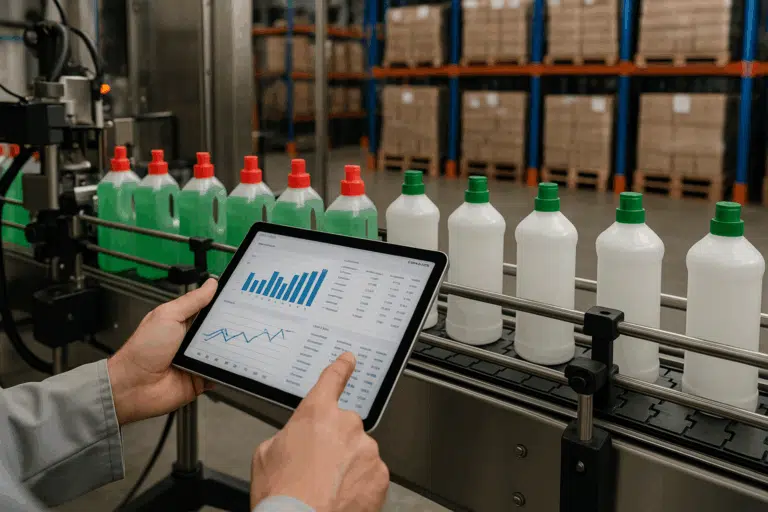RFID integration with SAP (Systems, Applications, and Products) offers significant benefits for businesses in terms of improving inventory management and supply chain visibility. By integrating RFID technology with SAP systems, businesses can automate and streamline data capture processes, enabling real-time tracking and monitoring of assets, products, and shipments.
RFID tags attached to items can be scanned by RFID readers, which then transmit the data directly to the SAP system, eliminating the need for manual data entry and reducing human errors.
This integration enhances accuracy, efficiency, and speed in inventory management, enabling businesses to have up-to-date information on stock levels, locations, and movements. It also enables better traceability, reduces stockouts, enhances supply chain visibility, and facilitates more accurate demand forecasting. Overall, RFID integration with SAP empowers businesses with real-time, accurate, and actionable insights, leading to improved operational efficiency and better decision-making.
Table of Contents
ToggleH2: Understanding RFID and SAP
What is RFID?
RFID (Radio Frequency Identification) is a technology that uses radio waves to wirelessly identify and track objects or people. It consists of three components: an RFID tag, an RFID reader, and a backend system. The RFID tag is a small electronic device that contains a unique identifier and can be attached to or embedded in objects. The RFID reader emits radio waves and captures the data transmitted by the tags within its range.
This data is then processed and communicated to a backend system, which can be used for various applications such as inventory management, supply chain tracking, access control, or asset tracking. RFID technology offers advantages over traditional barcode systems as it enables non-contact and automatic identification, allowing for faster and more efficient data capture and real-time tracking capabilities.
The Role of SAP in Business Processes
SAP (Systems, Applications, and Products) plays a crucial role in modern businesses as a leading provider of enterprise software solutions. SAP offers a range of integrated modules and applications that support various business processes, including finance, human resources, supply chain management, customer relationship management, and more. Its role is to streamline and optimize business operations by providing a centralized platform for data management, process automation, and real-time reporting.
SAP enables businesses to standardize and harmonize their processes, enhance collaboration across departments, and improve decision-making through access to accurate and timely information. It also facilitates the integration of different functional areas, allowing for seamless data flow and enabling organizations to achieve operational efficiency, cost savings, and better customer service. With its extensive capabilities and industry-specific solutions, SAP plays a fundamental role in enabling businesses to drive growth, adapt to changing market dynamics, and stay competitive in today’s digital era.
The Benefits of RFID Integration with SAP
Real-time Data Access
The integration of RFID technology with SAP enables businesses to have real-time data access, revolutionizing the way they manage and track their assets, inventory, and supply chain. RFID tags attached to items can be scanned by RFID readers, instantly capturing data such as item identification, location, and movement. This data is seamlessly transmitted to the SAP system in real-time, providing businesses with accurate and up-to-date information.
With real-time data access, businesses can make informed decisions, respond quickly to changing conditions, and optimize their operations. They gain visibility into inventory levels, can identify and address issues promptly, and improve overall efficiency. Real-time data access in RFID integration with SAP empowers businesses with the insights they need to enhance productivity, reduce costs, and deliver superior customer service.
Improved Inventory Management
RFID integration with SAP brings significant improvements to inventory management processes. By attaching RFID tags to inventory items and integrating them with the SAP system, businesses can achieve real-time visibility and accuracy in tracking their inventory.
RFID readers can quickly scan multiple items simultaneously, capturing data such as item identification, quantity, location, and movement. This enables businesses to have a comprehensive view of their inventory levels and locations at any given moment. The automation and accuracy provided by RFID integration eliminate manual data entry errors and reduce the time and effort required for inventory counting and reconciliation.
With improved inventory management in RFID integration with SAP, businesses can optimize their stock levels, reduce stockouts and overstocks, improve order fulfillment, and enhance overall operational efficiency. They can make data-driven decisions, implement proactive inventory control measures, and deliver better customer satisfaction through timely and accurate order processing.
Enhanced Asset Tracking
RFID integration with SAP brings significant enhancements to asset tracking capabilities for businesses. By attaching RFID tags to assets and integrating them with the SAP system, organizations gain real-time visibility and accuracy in tracking their assets throughout their lifecycle.
RFID readers can quickly and automatically capture asset data, including identification, location, and status, providing up-to-date information on asset movements and utilization. This enables businesses to improve asset inventory accuracy, reduce instances of loss or theft, and streamline maintenance and repair processes. The integration also enables proactive asset management by providing alerts for maintenance schedules, asset retirement, or lease renewals.
With enhanced asset tracking in RFID integration with SAP, businesses can optimize asset utilization, reduce costs associated with lost or underutilized assets, improve asset maintenance efficiency, and make informed decisions based on accurate and real-time asset information.
RFID Integration with SAP EWM
Overview of SAP EWM
SAP Extended Warehouse Management (SAP EWM) is a comprehensive solution designed to optimize warehouse operations and improve inventory management. It provides businesses with advanced capabilities for inbound and outbound logistics, inventory tracking, and warehouse process automation.
SAP EWM offers features such as advanced picking strategies, wave management, slotting optimization, and labor management, enabling businesses to streamline their warehouse operations and increase efficiency. The solution provides real-time visibility into inventory levels, locations, and movements, empowering businesses to make data-driven decisions, improve order fulfillment accuracy, and enhance customer satisfaction.
With its integration capabilities with other SAP modules and external systems, SAP EWM offers a scalable and flexible solution that can meet the complex warehousing needs of businesses across various industries.
The Process of RFID Integration with SAP EWM
The process of RFID integration with SAP EWM typically involves several steps to ensure seamless data flow and functionality. Here is a high-level overview of the process:
- RFID Tagging: Assets or inventory items are equipped with RFID tags containing unique identifiers. These tags can be attached or embedded in the items.
- RFID Readers: RFID readers are strategically placed throughout the warehouse or facility. These readers emit radio waves to capture data from the RFID tags in their vicinity.
- RFID Middleware: An RFID middleware acts as a bridge between the RFID readers and the SAP EWM system. It collects data from the RFID readers and prepares it for integration with SAP EWM.
- Integration Configuration: The RFID middleware is configured to communicate with the SAP EWM system. This involves defining data formats, protocols, and mappings between RFID tag data and the corresponding SAP EWM fields.
- Data Transmission: The RFID middleware transmits the captured RFID data to the SAP EWM system. This data includes information such as item identification, location, and movement.
- SAP EWM Integration: The SAP EWM system receives and processes the RFID data. The data is mapped to the relevant SAP EWM fields and stored in the system’s database.
- Real-time Tracking and Reporting: With the integration in place, the SAP EWM system provides real-time visibility into the location, status, and movements of assets or inventory items. This information can be accessed through SAP EWM’s user interface or through customized reports and dashboards.
Throughout the process, it is important to ensure data accuracy, system compatibility, and synchronization between the RFID middleware and the SAP EWM system. Thorough testing, validation, and monitoring are essential to ensure the successful integration and ongoing performance of the RFID integration with SAP EWM.
Real-world Example of RFID Usage in SAP EWM
One real-world example of RFID usage in SAP EWM is seen in the logistics industry. A large logistics company implemented RFID technology integrated with SAP EWM to enhance their warehouse operations and improve inventory management. They tagged their inventory items and equipped their warehouse with RFID readers strategically placed at key points such as receiving docks, picking stations, and shipping areas. As goods arrived, the RFID tags were automatically scanned, capturing data such as item identification, quantity, and location. This data was seamlessly transmitted to the SAP EWM system in real-time, providing accurate and up-to-date information on inventory levels and movements. With this implementation, the company achieved significant benefits, including improved inventory accuracy, reduced manual data entry errors, streamlined order fulfillment processes, and enhanced supply chain visibility. The integration of RFID technology with SAP EWM enabled the logistics company to optimize their warehouse operations, increase efficiency, and deliver better customer service.
RFID Integration with Other SAP Modules
RFID Integration with SAP Manufacturing
RFID integration with SAP Manufacturing offers significant advantages in improving visibility, traceability, and efficiency throughout the manufacturing process. By leveraging RFID technology, manufacturers can tag their products, components, and equipment, enabling real-time tracking and data capture. Integrated with SAP Manufacturing, this data can be seamlessly transmitted and processed, providing accurate information on inventory levels, work-in-progress status, and production workflows.
RFID integration enhances supply chain visibility, reduces errors, and enables proactive decision-making. It enables manufacturers to optimize production planning, streamline material flow, and improve quality control. By leveraging RFID technology in conjunction with SAP Manufacturing, manufacturers can achieve greater operational efficiency, cost savings, and enhanced customer satisfaction.
RFID Integration with SAP Asset Management
RFID integration with SAP Asset Management brings significant benefits in improving asset tracking and management processes. By attaching RFID tags to assets and integrating them with SAP Asset Management, organizations can achieve real-time visibility and accurate tracking of their assets. RFID readers capture data from the tags, such as asset identification, location, and maintenance history, and seamlessly transmit it to the SAP system.
This integration enables organizations to have up-to-date information on asset locations, utilization, and maintenance schedules. It streamlines asset tracking, reduces manual data entry errors, and improves asset maintenance efficiency. With RFID integration, organizations can optimize asset utilization, reduce costs associated with lost or underutilized assets, and make informed decisions based on accurate and real-time asset information. Overall, RFID integration with SAP Asset Management empowers organizations to improve asset visibility, enhance maintenance processes, and maximize the value of their assets.
RFID Integration with SAP Retail
RFID integration with SAP Retail offers significant advantages in improving inventory management and enhancing the customer shopping experience. By leveraging RFID technology, retailers can tag their products with RFID tags and integrate them with SAP Retail systems.
This integration enables real-time tracking and monitoring of inventory levels, locations, and movements. RFID readers placed strategically throughout the retail environment capture data from the tags, providing accurate and up-to-date information on stock availability. This real-time visibility allows retailers to optimize their inventory, reduce stockouts, and improve replenishment processes. Additionally, RFID integration enhances the accuracy of stocktaking, minimizing manual errors and improving inventory accuracy.
Retailers can also leverage RFID technology for interactive customer experiences, such as self-checkout or smart shelves that provide product information and recommendations. RFID integration with SAP Retail enables retailers to streamline operations, improve inventory management, and deliver a seamless and personalized shopping experience to customers.
Challenges and Solutions in RFID Integration with SAP
Common Challenges in RFID Integration with SAP
- Data Accuracy and Integrity: Maintaining data accuracy and integrity can be a challenge in RFID integration with SAP. RFID systems generate a large volume of data, and ensuring that the data captured from RFID tags is accurately transmitted, processed, and integrated into SAP systems requires robust data validation and cleansing processes. Data inconsistencies or errors can lead to inaccurate inventory records, incorrect stock levels, and disruptions in supply chain operations.
- System Complexity and Integration: Integrating RFID technology with SAP involves complex technical integration processes. Organizations need to establish a seamless flow of data between RFID readers, middleware, and SAP systems.
This requires careful planning, configuration, and testing to ensure smooth data transmission, synchronization, and integration. Handling different data formats, protocols, and interfaces can pose technical challenges and may require expertise in both RFID technology and SAP integration. - Change Management and User Adoption: Introducing RFID technology and SAP integration can require significant changes in workflows, processes, and user behavior. Employees may need to adapt to new data capture methods, use different devices or interfaces, and embrace new procedures.
Change resistance, lack of training, or inadequate communication about the benefits of RFID integration can hinder user adoption. Proper change management strategies, user training, and ongoing support are crucial to ensure smooth adoption and maximize the benefits of RFID integration with SAP.
Practical Solutions for Successful RFID Integration with SAP
Comprehensive Planning and Requirements Gathering: Before embarking on RFID integration with SAP, organizations should conduct a thorough planning phase that includes gathering requirements from key stakeholders.
This involves understanding the specific business needs, defining the scope of integration, and identifying the desired outcomes. By conducting a comprehensive assessment of the current processes, infrastructure, and data requirements, organizations can align their RFID implementation strategy with the goals and objectives of the SAP integration.
- Robust System Architecture and Integration Framework: Implementing a robust system architecture and integration framework is essential for smooth RFID integration with SAP. This includes selecting the appropriate middleware or integration platform that can efficiently handle data flow between the RFID infrastructure and SAP systems.
Organizations should carefully design and configure the integration framework to ensure seamless data synchronization, transformation, and mapping between RFID readers, middleware, and SAP modules. It is also important to establish proper data validation and error handling mechanisms to ensure data accuracy and integrity. - Rigorous Testing and Piloting: Testing and piloting the RFID integration with SAP is critical to identify and address any issues or challenges before full-scale implementation. Organizations should conduct thorough testing of the integrated system, including data transmission, integration points, and end-to-end processes.
Piloting the RFID solution in a controlled environment or specific areas of the business can provide valuable insights and allow for fine-tuning of the integration. It is crucial to involve key users and stakeholders during the testing and piloting phase to gather feedback and ensure that the integrated solution meets their needs.
Comparing RFID with Other Technologies in SAP Integration
RFID vs Barcode in SAP Integration
RFID and barcode technologies play distinct roles in SAP integration. RFID offers advantages such as wireless and automated data capture, the ability to read multiple items simultaneously, and better resistance to environmental factors. It allows for real-time visibility and provides more data flexibility with larger storage capacity on RFID tags.
On the other hand, barcodes are more cost-effective, simpler to implement, and widely supported. While barcodes require line-of-sight scanning and may be limited by their capacity and susceptibility to wear and tear, they remain a reliable option for identification purposes.
The choice between RFID and barcodes in SAP integration depends on factors like operational needs, budget, and the complexity of the tracking and identification requirements.
The Future of RFID and IoT in SAP
The future of RFID and IoT (Internet of Things) in SAP holds great potential for revolutionizing various industries. As IoT devices continue to proliferate and become more interconnected, the integration of RFID technology with SAP will enable seamless data exchange and provide real-time insights across the supply chain, manufacturing processes, and asset management.
With advancements in sensor technology, RFID tags will become smaller, cheaper, and more energy-efficient, expanding their applicability in diverse settings.
This integration will enhance operational efficiency, enable predictive maintenance, optimize inventory management, and facilitate intelligent decision-making. Additionally, the integration of RFID and IoT with SAP will support emerging trends such as smart cities, connected products, and digital supply chains.
The future holds exciting opportunities for organizations to harness the power of RFID and IoT in conjunction with SAP to drive innovation and gain a competitive edge in the digital era.
Step-by-step Guide for RFID Integration with SAP
Prerequisites for RFID Integration with SAP
Before embarking on RFID integration with SAP, there are several prerequisites that organizations should consider:
- Clear Business Objectives: Clearly define the business objectives and expected outcomes of the RFID integration with SAP. Identify the specific areas where RFID technology will be applied, such as inventory management, asset tracking, or supply chain optimization. Having a clear understanding of the goals will help in designing and implementing the integration effectively.
- SAP System Readiness: Ensure that the SAP system is capable of integrating with RFID technology. Check if the necessary modules and functionalities are available in the SAP environment to support RFID integration. If required, consult with SAP experts or consultants to determine the compatibility and potential system enhancements or upgrades needed.
- RFID Infrastructure: Establish a robust RFID infrastructure that includes RFID tags, readers, and middleware. Choose RFID tags that are compatible with the SAP integration requirements and suitable for the intended use case. Select RFID readers that can effectively capture data from the tags and transmit it to the SAP system. Consider the scalability and future expansion of the RFID infrastructure to accommodate increasing data volumes and new use cases.
- Data Mapping and Integration: Define the data mapping and integration requirements between the RFID infrastructure and SAP system. Determine how the RFID data will be transmitted, transformed, and mapped into the appropriate SAP modules or databases. Plan for data validation and cleansing processes to ensure data accuracy and integrity during integration.
- Change Management and User Training: Prepare for organizational change management and user training to ensure a smooth transition to the RFID integration with SAP. Communicate the benefits of RFID technology to stakeholders and end-users, and provide adequate training to employees who will be working with the integrated system. Address any potential resistance to change and ensure that users are prepared to adopt the new processes and technologies.
By addressing these prerequisites, organizations can lay a solid foundation for successful RFID integration with SAP. This will help in aligning business objectives, preparing the SAP system, establishing the RFID infrastructure, and ensuring smooth user adoption, ultimately maximizing the benefits of the integration.
Configuration Steps for RFID Integration with SAP
Configuring RFID integration with SAP involves several steps to ensure a seamless integration and data flow between the RFID infrastructure and SAP system. Here are the general configuration steps for RFID integration with SAP:
- Define RFID Data Structure: Determine the structure and content of the RFID data that will be captured and transmitted to SAP. This includes identifying the fields and attributes that need to be extracted from RFID tags, such as unique identifiers, product information, or location data.
- Configure RFID Middleware: Set up the RFID middleware or integration platform that will serve as the interface between the RFID infrastructure and SAP. Configure the middleware to receive data from RFID readers, apply necessary transformations or mappings, and transmit the data to the appropriate SAP modules or databases.
- Configure SAP System: Configure the SAP system to receive and process the RFID data. This involves creating the necessary data structures, such as tables or fields, to store the RFID data in the SAP database. Configure the SAP modules relevant to the integration, such as Inventory Management, Warehouse Management, or Asset Management, to accommodate the RFID data and enable seamless integration.
- Map RFID Data to SAP Fields: Define the mapping between the RFID data and the corresponding SAP fields. Determine which RFID data elements correspond to which SAP fields, ensuring that the data is correctly extracted, transformed, and loaded into the SAP system.
- Define Integration Triggers and Events: Specify the triggers or events that initiate the RFID data integration with SAP. For example, define the event that signifies a successful RFID tag read and triggers the transmission of data to SAP. Configure any relevant business rules or validation checks to ensure data integrity and accuracy during integration.
- Test and Validate the Integration: Conduct thorough testing to validate the RFID integration with SAP. Test data transmission, mapping, and processing to ensure that RFID data is correctly captured, transmitted, and integrated into the SAP system. Perform end-to-end testing with real-world scenarios to validate the functionality and reliability of the integration.
- Monitor and Maintain the Integration: Set up monitoring and maintenance processes to ensure the ongoing performance and stability of the RFID integration with SAP. Monitor data flows, error logs, and system performance to detect any issues or anomalies. Regularly review and update the configuration as needed to accommodate changes in the RFID infrastructure or SAP system.
It is important to note that the specific configuration steps may vary depending on the RFID middleware, SAP modules, and business requirements. Working closely with RFID and SAP experts or consultants is recommended to ensure a successful configuration of the RFID integration with SAP.
Testing and Troubleshooting Tips for RFID Integration with SAP
When testing and troubleshooting RFID integration with SAP, organizations can follow these tips to ensure a smooth integration and address any issues that may arise:
- Define Test Scenarios: Identify and define test scenarios that cover various aspects of the RFID integration, such as data capture, transmission, mapping, and integration with SAP. Create test cases that encompass different use cases, data volumes, and scenarios to validate the functionality and performance of the integration.
- Use Sample Data: Generate sample RFID data that represents typical scenarios and test it against the integration. This allows for testing different data formats, field lengths, and data variations to ensure that the integration can handle a wide range of RFID data inputs.
- Test Data Transmission: Test the transmission of RFID data from the RFID infrastructure to the SAP system. Verify that the data is being correctly captured by the RFID readers, transmitted to the middleware, and integrated into the SAP system without any loss or corruption. Monitor data transmission speeds, data volume handling, and data validation processes.
- Validate Data Mapping: Validate the mapping of RFID data to the corresponding SAP fields. Verify that the RFID data elements are correctly mapped and transformed into the appropriate SAP data structures. Test scenarios with different data mappings, including variations in field lengths, data types, and special characters, to ensure that the integration handles them accurately.
- Perform End-to-End Testing: Conduct end-to-end testing to simulate real-world scenarios and validate the entire process from RFID data capture to SAP integration. Test the integration with different SAP modules or functionalities, such as inventory management, asset tracking, or production planning, to ensure seamless data flow and system interoperability.
- Monitor Error Logs: Monitor error logs and system messages generated during testing to identify any issues or anomalies. Investigate and resolve any error messages or exceptions encountered during the testing process. Pay attention to any data validation errors, data inconsistencies, or system performance issues that may indicate potential integration problems.
- Collaborate with Experts: Seek assistance from RFID and SAP experts or consultants for troubleshooting and resolving integration issues. Their expertise can help identify root causes, suggest solutions, and provide guidance on optimizing the integration setup.
- Document Issues and Solutions: Document any issues encountered during testing and troubleshooting, along with the corresponding solutions or workarounds. This documentation will be valuable for future reference, system maintenance, and knowledge transfer within the organization.
By following these testing and troubleshooting tips, organizations can identify and resolve integration issues, validate the functionality and performance of the RFID integration with SAP, and ensure a successful implementation of the integrated system.
Conclusion
In conclusion, understanding the integration of RFID and SAP provides organizations with a powerful solution for enhancing operational efficiency, visibility, and decision-making across various business processes.
The benefits of RFID integration with SAP are numerous, including real-time data access, improved inventory management, enhanced asset tracking, and streamlined business processes.
Integration with SAP EWM enables optimized warehouse operations, while integration with other SAP modules extends the benefits to areas such as manufacturing, asset management, and retail. However, challenges may arise in RFID integration with SAP, such as data accuracy, system compatibility, and change management.
These challenges can be overcome through practical solutions like thorough testing, effective change management strategies, and collaboration with experts. When comparing RFID with other technologies in SAP integration, organizations need to consider factors such as data capture capabilities, flexibility, cost, and environmental suitability.
A step-by-step guide for RFID integration with SAP involves pre-requisites, configuration steps, and testing and troubleshooting tips to ensure a successful integration that delivers tangible business benefits.
By leveraging the power of RFID and SAP integration, organizations can drive efficiency, accuracy, and visibility across their operations, leading to improved productivity and customer satisfaction.
FAQs
What are the costs associated with RFID integration with SAP?
The costs associated with RFID integration with SAP can vary depending on various factors, including the scale of the integration, the complexity of the RFID infrastructure, and the specific requirements of the SAP system. The costs can include hardware expenses for RFID readers, tags, and antennas, as well as the cost of RFID middleware or integration platforms.
Implementation costs may also include customization and configuration of the SAP system to accommodate RFID data, as well as the cost of professional services for system integration and training. Additionally, ongoing costs can include maintenance and support, RFID tag replenishment, and potential infrastructure upgrades.
It is essential for organizations to carefully evaluate their RFID integration needs, consider the long-term benefits, and work closely with RFID and SAP experts to determine the associated costs and develop a cost-effective implementation plan.
How does RFID integration with SAP improve supply chain management?
RFID integration with SAP significantly enhances supply chain management by providing real-time visibility and accurate tracking of goods throughout the entire supply chain. By attaching RFID tags to products, assets, or containers, organizations can capture and transmit data automatically, eliminating the need for manual data entry and reducing errors.
This real-time visibility enables better inventory management, optimizing stock levels, and reducing stockouts or excess inventory.
RFID integration also improves asset tracking, allowing organizations to locate and monitor assets throughout the supply chain, minimizing loss and improving asset utilization. Additionally, RFID integration with SAP enables seamless data sharing and collaboration with suppliers and partners, facilitating efficient demand planning, order fulfillment, and logistics management.
Overall, RFID integration with SAP empowers organizations to streamline operations, reduce costs, enhance customer satisfaction, and gain a competitive edge in the dynamic world of supply chain management.
Can RFID integration with SAP support real-time decision making?
Yes, RFID integration with SAP can support real-time decision making by providing accurate and up-to-date data throughout the supply chain and business processes. RFID technology enables the automatic and continuous capture of data, such as product movements, inventory levels, and asset locations, in real-time.
This data is then integrated into the SAP system, allowing for immediate visibility and analysis. With real-time data access, organizations can make informed decisions based on the most current information, enabling timely actions to optimize operations, respond to changes in demand or supply, and address any potential issues or bottlenecks.
Real-time decision making supported by RFID integration with SAP helps organizations improve responsiveness, agility, and overall efficiency in their day-to-day operations, contributing to enhanced customer satisfaction and business performance.
What are the security considerations for RFID integration with SAP?
Security considerations for RFID integration with SAP are crucial to protect sensitive data and ensure the integrity of the system. Organizations should implement robust security measures to safeguard against unauthorized access, data breaches, and potential threats.
This includes implementing strong authentication mechanisms, such as secure user credentials and role-based access controls, to restrict system access to authorized personnel only. Encryption techniques should be employed to secure data transmission between RFID devices, middleware, and the SAP system. Regular system audits and monitoring should be conducted to detect any suspicious activities or potential vulnerabilities.
Additionally, organizations should stay updated with the latest security patches and updates for both the RFID infrastructure and SAP system. Employee training and awareness programs are essential to educate users about security best practices and mitigate the risk of social engineering attacks. By prioritizing security considerations, organizations can ensure the confidentiality, integrity, and availability of data within the RFID integration with SAP, safeguarding critical information and maintaining the trust of customers and stakeholders.
How to choose the right tags for RFID Integration with SAP?
When choosing tags for RFID integration with SAP, several factors should be considered to ensure compatibility and effectiveness. First, assess the environmental conditions in which the tags will be used, such as temperature, moisture, and exposure to chemicals, to select tags that are suitable for those conditions.
Consider the read range and read rate requirements to determine the appropriate tag type, such as passive or active tags. Evaluate the durability and longevity of the tags to ensure they can withstand the intended use and provide a reasonable lifespan.
Compatibility with the RFID readers and middleware being used is essential, so verify that the chosen tags are compatible with the RFID infrastructure and can communicate seamlessly with SAP. Additionally, consider the tag’s form factor and attachment method to ensure easy and reliable attachment to the items being tagged. Finally, take into account the cost implications and consider the balance between tag cost and performance requirements.
By considering these factors, organizations can select the right tags for RFID integration with SAP, ensuring optimal performance and data accuracy throughout the RFID-enabled processes.



























